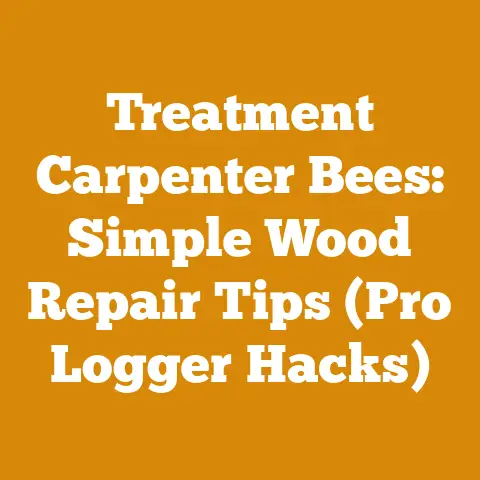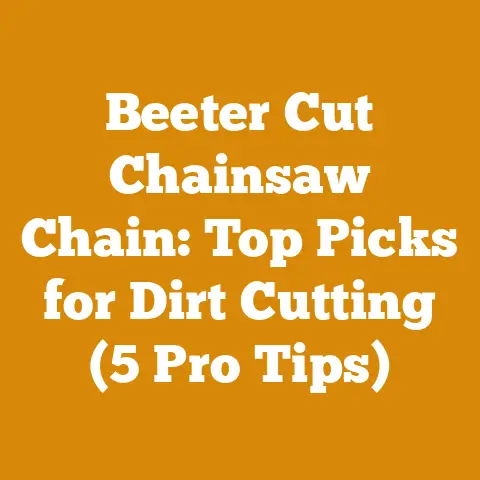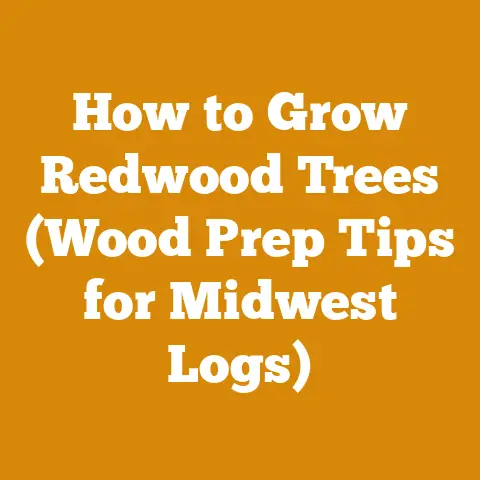Killing Honeysuckle for Woodlands (Effective Clearing Techniques)
Have you ever looked out at what should be a vibrant, diverse woodland and instead seen a sea of green, choked by an invasive vine?
That vine is often honeysuckle, and it’s a problem I’ve battled personally for years.
Effective honeysuckle clearing isn’t just about aesthetics; it’s about protecting the health and biodiversity of our woodlands, and, frankly, making our jobs as wood processors and firewood producers easier in the long run.
My experience in timber harvesting and firewood production has shown me firsthand the detrimental effects of unchecked honeysuckle growth.
It competes with native trees for sunlight and nutrients, hindering their growth and even killing them.
This impacts the quality and quantity of timber available, and makes accessing firewood stands a real nightmare.
I’ve spent countless hours hacking through dense honeysuckle thickets just to reach a fallen oak or maple.
So, let’s dive into effective honeysuckle clearing techniques that I’ve found successful.
Understanding the Enemy: Honeysuckle Identification and Impact
Before you start swinging a machete, it’s crucial to know what you’re up against.
Several honeysuckle species, particularly Japanese honeysuckle ( Lonicera japonica) and bush honeysuckles ( Lonicera maackii, Lonicera tatarica, and Lonicera morrowii), are invasive in North America and other regions.
Identification:
- Japanese Honeysuckle: A trailing or climbing vine with fragrant white or yellowish flowers that bloom in spring and summer.
The leaves are opposite, oval-shaped, and sometimes lobed. - Bush Honeysuckles: Upright shrubs with opposite, oval leaves and fragrant white, pink, or red flowers that bloom in late spring.
They produce red or orange berries in the fall.
- Japanese Honeysuckle: A trailing or climbing vine with fragrant white or yellowish flowers that bloom in spring and summer.
Impact:
- Competition: Honeysuckle outcompetes native plants for sunlight, water, and nutrients.
- Allelopathy: Some honeysuckle species release chemicals that inhibit the growth of other plants.
- Habitat Degradation: Dense honeysuckle thickets can reduce habitat for wildlife.
- Increased Fire Risk: Dry honeysuckle foliage can increase the risk and intensity of wildfires.
- Hindrance to Timber Operations: As I mentioned earlier, dense honeysuckle makes accessing timber and firewood stands incredibly difficult, increasing labor costs and reducing efficiency.
Imagine trying to drag a freshly felled oak through a tangled mess of vines – not fun!
Strategic Honeysuckle Clearing: Planning Your Attack
Effective honeysuckle clearing requires a strategic approach.
Don’t just randomly start cutting; plan your attack based on the size of the infestation, the surrounding vegetation, and your available resources.
Assessment:
- Extent of Infestation: Determine the area covered by honeysuckle.
Is it a small patch or a large, widespread infestation? - Density: How dense is the honeysuckle growth?
Is it a light ground cover or a thick, impenetrable thicket? - Surrounding Vegetation: Identify the desirable plants you want to protect.
Be mindful of native trees, shrubs, and wildflowers. - Soil Type and Topography: Consider the soil type and topography of the area.
This will influence your choice of clearing methods.
- Extent of Infestation: Determine the area covered by honeysuckle.
-
Timing:
- Late Fall/Early Winter: This is often the best time to clear honeysuckle because the plants are dormant, and native vegetation has lost its leaves, making it easier to identify and target honeysuckle.
- Late Summer/Early Fall (for Herbicide Application): If you’re using herbicides, this is a good time to apply them because the plants are actively transporting nutrients to their roots, which will help the herbicide be more effective.
Choosing Your Method:
- Manual Removal: Cutting, pulling, and digging up honeysuckle.
This is best for small infestations and areas where you want to avoid using herbicides. - Chemical Control: Applying herbicides to kill honeysuckle.
This is best for large infestations or areas where manual removal is impractical. - Combination Approach: Using a combination of manual removal and chemical control.
This is often the most effective approach. - Prescribed Burning: In some cases, controlled burns can be used to kill honeysuckle and promote the growth of native plants.
However, this method requires careful planning and execution and should only be done by trained professionals.
- Manual Removal: Cutting, pulling, and digging up honeysuckle.
Tools of the Trade: Essential Equipment for Honeysuckle Clearing
Having the right tools is essential for efficient and safe honeysuckle clearing.
Here’s a rundown of the equipment I use and recommend:
Cutting Tools:
- Hand Pruners: For cutting small stems and branches.
Look for pruners with sharp, bypass blades for clean cuts.
I prefer Felco pruners for their durability and precision. - Loppers: For cutting larger stems and branches.
Loppers provide more leverage than hand pruners, making it easier to cut thicker stems. - Machete: For clearing dense thickets of honeysuckle.
A sharp machete can quickly cut through vines and stems.
Choose a machete with a comfortable handle and a durable blade. - Brush Axe: For cutting larger stems and saplings.
A brush axe is similar to a machete but with a heavier blade and a longer handle. - Chainsaw: For cutting large stems and trees.
A chainsaw is essential for clearing large infestations of honeysuckle.
I recommend a professional-grade chainsaw with a 16-18 inch bar.
My go-to is a Stihl MS 261 C-M. - Brush Cutter/Weed Whacker with Blade Attachment: For clearing large areas of honeysuckle.
A brush cutter with a blade attachment can quickly cut through vines and stems.
Be sure to wear appropriate safety gear when using a brush cutter.
I use a Stihl FS 91 R with a metal blade.
- Hand Pruners: For cutting small stems and branches.
Digging Tools:
- Shovel: For digging up honeysuckle roots.
A sturdy shovel is essential for removing the entire root system. - Mattock: For digging up large roots and breaking up hard soil.
A mattock is a versatile tool that can be used for a variety of tasks. - Weed Wrench: For pulling up small to medium-sized honeysuckle plants.
A weed wrench provides leverage to easily pull up the entire root system.
- Shovel: For digging up honeysuckle roots.
-
Safety Gear:
- Eye Protection: Safety glasses or goggles to protect your eyes from flying debris.
- Gloves: Heavy-duty work gloves to protect your hands from thorns and cuts.
- Long Sleeves and Pants: To protect your skin from scratches and insect bites.
- Sturdy Boots: To protect your feet and ankles.
- Hearing Protection: Earplugs or earmuffs to protect your hearing when using power tools.
- Hard Hat: To protect your head from falling branches and debris.
- Chainsaw Chaps (if using a chainsaw): To protect your legs from chainsaw injuries.
-
Herbicide Application Equipment (if using herbicides):
- Backpack Sprayer: For applying herbicides to large areas.
- Handheld Sprayer: For applying herbicides to small areas or individual plants.
- Gloves and Protective Clothing: To protect your skin from herbicide exposure.
- Eye Protection: To protect your eyes from herbicide exposure.
Tool Specifications and Recommendations:
- Chainsaw: Stihl MS 261 C-M (16-18 inch bar).
This is a professional-grade chainsaw that is lightweight, powerful, and reliable.
The “C-M” designation indicates that it has Stihl’s M-Tronic engine management system, which automatically adjusts the engine settings for optimal performance. - Brush Cutter: Stihl FS 91 R with a metal blade.
This brush cutter is powerful and versatile.
The metal blade is ideal for cutting through dense honeysuckle. - Loppers: Corona Clipper SL 7180.
These loppers are durable and have sharp, bypass blades for clean cuts. - Hand Pruners: Felco F-8.
Felco pruners are known for their quality and durability.
The F-8 model is a good all-around pruner for general use.
Manual Honeysuckle Removal: Getting Your Hands Dirty
Manual honeysuckle removal is a labor-intensive but effective method for controlling small to medium-sized infestations.
It’s also the preferred method in areas where you want to avoid using herbicides.
-
Cutting:
- Use hand pruners, loppers, or a machete to cut the honeysuckle stems at ground level.
- For vines climbing trees, cut the vines at the base and several feet up to prevent them from re-rooting.
- Remove the cut stems and vines from the area to prevent them from re-sprouting.
-
Pulling:
- Use a weed wrench or your hands to pull up small to medium-sized honeysuckle plants.
- Grasp the plant at the base and pull firmly but gently to avoid breaking the stem.
- Try to remove as much of the root system as possible.
-
Digging:
- Use a shovel or mattock to dig up the roots of larger honeysuckle plants.
- Loosen the soil around the roots and carefully lift the plant out of the ground.
- Remove as much of the root system as possible.
Case Study: My Backyard Honeysuckle Battle
I had a significant honeysuckle problem in my backyard, which borders a small wooded area.
The honeysuckle was choking out my native shrubs and flowers.
I decided to tackle it manually.
I started by cutting all the honeysuckle stems at ground level using loppers and a machete.
Then, I used a weed wrench to pull up the smaller plants.
For the larger plants, I had to dig up the roots using a shovel and mattock.
It was hard work, but I was able to remove a significant amount of honeysuckle.
After removing the honeysuckle, I planted native shrubs and flowers to fill in the gaps.
I also mulched the area to help suppress weed growth.
It took several years of consistent effort, but I was eventually able to get the honeysuckle under control and restore the health of my backyard ecosystem.
Benefits of Manual Removal:
- Environmentally Friendly: No herbicides are used.
- Selective: You can target specific plants without harming desirable vegetation.
- Effective: Can be very effective for controlling small to medium-sized infestations.
Drawbacks of Manual Removal:
- Labor-Intensive: Requires a significant amount of time and effort.
- Re-Sprouting: Honeysuckle can re-sprout from roots left in the ground.
- Limited Applicability: Not practical for large infestations.
Chemical Control: When Herbicides Are Necessary
Chemical control is a useful tool for managing large honeysuckle infestations or areas where manual removal is impractical.
However, it’s important to use herbicides responsibly and follow all label instructions.
Herbicide Selection:
- Glyphosate: A non-selective herbicide that kills most plants it comes into contact with.
It’s effective on honeysuckle but should be used carefully to avoid harming desirable vegetation.
I use a glyphosate product with a concentration of around 41%. - Triclopyr: A selective herbicide that targets broadleaf plants, including honeysuckle.
It’s less likely to harm grasses and other monocots.
I often use triclopyr for foliar applications when desirable grasses are present. - Imazapyr: A non-selective herbicide that provides long-term control.
It can be used as a soil treatment or a foliar spray.
Use with caution, as it can persist in the soil and harm desirable plants.
- Glyphosate: A non-selective herbicide that kills most plants it comes into contact with.
Application Methods:
- Foliar Spray: Applying herbicide directly to the leaves of the honeysuckle.
This is most effective when the plants are actively growing. - Cut-Stump Treatment: Cutting the honeysuckle stems at ground level and applying herbicide to the freshly cut stumps.
This prevents the plants from re-sprouting. - Basal Bark Treatment: Applying herbicide to the lower portion of the honeysuckle stems.
This is effective on thin-barked plants. - Soil Application: Applying herbicide to the soil around the base of the honeysuckle plants.
This is effective for providing long-term control.
- Foliar Spray: Applying herbicide directly to the leaves of the honeysuckle.
Detailed Steps for Cut-Stump Treatment:
This is the method I find most effective for larger honeysuckle plants.
- Cut the Stems: Using a chainsaw or loppers, cut the honeysuckle stems as close to the ground as possible.
Make a clean, horizontal cut. - Prepare the Herbicide: Mix the herbicide according to the label instructions.
I typically use a glyphosate solution with a concentration of 20-25% for cut-stump treatments. - Apply the Herbicide: Immediately after cutting the stems, apply the herbicide to the freshly cut surface.
Use a paintbrush, spray bottle, or squirt bottle to saturate the entire cut surface.
Be sure to apply the herbicide to the outer edges of the stump, as this is where the cambium layer (the growing tissue) is located. - Monitor and Repeat: Check the treated stumps periodically for re-sprouting.
If you see any new growth, re-apply the herbicide.
Safety Precautions When Using Herbicides:
- Read and Follow Label Instructions: This is the most important safety precaution.
The label contains information on how to use the herbicide safely and effectively. - Wear Protective Clothing: Wear gloves, long sleeves, long pants, and eye protection to protect your skin and eyes from herbicide exposure.
- Avoid Spraying on Windy Days: Wind can carry herbicide droplets to non-target plants.
- Do Not Spray Near Water Sources: Herbicides can contaminate water sources.
- Store Herbicides Safely: Store herbicides in a secure location out of reach of children and pets.
Benefits of Chemical Control:
- Effective: Can be very effective for controlling large infestations.
- Efficient: Can treat a large area quickly.
- Long-Term Control: Some herbicides provide long-term control.
Drawbacks of Chemical Control:
- Environmental Concerns: Herbicides can harm non-target plants and animals.
- Safety Concerns: Herbicides can be toxic to humans.
- Resistance: Honeysuckle can develop resistance to herbicides over time.
Integrated Pest Management: A Holistic Approach
The most effective approach to honeysuckle control is integrated pest management (IPM).
IPM is a holistic approach that combines multiple control methods to minimize environmental impact and maximize effectiveness.
-
Prevention:
- Early Detection and Removal: Regularly inspect your property for honeysuckle and remove it before it becomes established.
- Plant Native Species: Plant native trees, shrubs, and wildflowers to compete with honeysuckle and prevent it from spreading.
- Maintain Healthy Ecosystems: Healthy ecosystems are more resistant to invasive species.
-
Monitoring:
- Regularly monitor your property for honeysuckle and other invasive species.
- Keep records of your control efforts and their effectiveness.
-
Control Methods:
- Use a combination of manual removal, chemical control, and other methods to control honeysuckle.
- Choose the most appropriate control methods based on the size of the infestation, the surrounding vegetation, and your available resources.
Strategic Insights for Long-Term Honeysuckle Management:
- Focus on the Edges: Honeysuckle often spreads from the edges of woodlands.
Focus your control efforts on these areas to prevent it from spreading further. - Prioritize High-Value Areas: Protect high-value areas, such as areas with rare or endangered plants, from honeysuckle infestation.
- Work with Neighbors: Honeysuckle can spread from neighboring properties.
Work with your neighbors to control honeysuckle on a regional scale. - Follow-Up is Key: Honeysuckle control is an ongoing process.
Regularly monitor your property for re-sprouting and new infestations and take action as needed.
Honeysuckle and Firewood: A Word of Caution
While honeysuckle itself isn’t typically used for firewood (it’s too small and doesn’t provide much heat), its presence can significantly impact firewood production.
As I mentioned earlier, dense honeysuckle thickets can make accessing firewood stands incredibly difficult.
It can also increase the risk of injury while felling trees and dragging logs.
Safety Considerations:
- Clear the Area: Before felling trees, clear a wide area around the tree to remove any honeysuckle that could pose a tripping hazard.
- Be Aware of Vines: Be aware of honeysuckle vines that may be attached to the tree you’re felling.
These vines can pull the tree in unexpected directions. - Use Caution When Dragging Logs: Be careful when dragging logs through honeysuckle thickets.
The vines can get tangled in the logs and make it difficult to move them.
Honeysuckle as a Fire Risk:
- Dry honeysuckle foliage can be a significant fire hazard.
Clear honeysuckle from around your firewood stacks to reduce the risk of fire. - Be extra cautious when using chainsaws or other power tools in areas with dry honeysuckle.
Sparks from these tools can ignite the dry foliage.
- Dry honeysuckle foliage can be a significant fire hazard.
Case Study: A Near Miss in the Woods
I was once felling a large oak tree in a heavily infested honeysuckle area.
I had cleared a path around the base of the tree, but I hadn’t noticed a thick honeysuckle vine that was attached to the top of the tree.
As the tree began to fall, the vine pulled it in an unexpected direction, causing it to land much closer to me than I had anticipated.
I was lucky to avoid being hit by the tree.
This experience taught me the importance of being extra cautious when working in areas with honeysuckle.
Restoring Woodlands After Honeysuckle Removal: Planting for the Future
Once you’ve cleared the honeysuckle, it’s important to restore the woodland ecosystem.
This involves planting native trees, shrubs, and wildflowers to compete with honeysuckle and provide habitat for wildlife.
Native Plant Selection:
- Choose native plants that are well-suited to the soil type and climate of your area.
- Consider the light conditions of the area.
Some plants prefer full sun, while others prefer shade. - Select a variety of plants to create a diverse and resilient ecosystem.
-
Planting Techniques:
- Plant trees and shrubs in the fall or early spring.
- Dig a hole that is twice as wide as the root ball and just as deep.
- Loosen the roots of the plant before planting.
- Backfill the hole with soil and water thoroughly.
- Mulch around the base of the plant to help retain moisture and suppress weed growth.
-
Ongoing Maintenance:
- Water the plants regularly, especially during dry periods.
- Weed around the plants to remove any competing vegetation.
- Protect the plants from deer and other herbivores.
Recommended Native Plants for Woodland Restoration:
- Trees: Oak ( Quercus spp.), Maple ( Acer spp.), Hickory ( Carya spp.), Dogwood ( Cornus florida), Redbud ( Cercis canadensis)
- Shrubs: Serviceberry ( Amelanchier spp.), Viburnum ( Viburnum spp.), Spicebush ( Lindera benzoin), Witch Hazel ( Hamamelis virginiana)
- Wildflowers: Trillium ( Trillium spp.), Bloodroot ( Sanguinaria canadensis), Wild Ginger ( Asarum canadense), Virginia Bluebells ( Mertensia virginica)
Conclusion: A Continuous Cycle of Stewardship
Controlling honeysuckle in woodlands is an ongoing process that requires dedication and a strategic approach.
It’s not a one-time fix, but a continuous cycle of stewardship.
By understanding the plant, choosing the right tools and methods, and restoring the ecosystem after removal, we can protect the health and biodiversity of our woodlands for generations to come.
As someone deeply involved in wood processing and firewood production, I see this as a crucial part of ensuring the sustainability of our resources.
A healthy woodland yields better timber, easier firewood access, and a more vibrant ecosystem overall.
So, get out there, plan your attack, and start reclaiming your woodlands from the grip of honeysuckle.
Your forests – and your future firewood piles – will thank you for it.
Now, armed with this knowledge, your next step is to assess your own property and identify the extent of your honeysuckle problem.
Start small, perhaps with a manual removal project in a manageable area.
Document your progress, learn from your experiences, and adapt your strategies as needed.
Remember, patience and persistence are key.
Don’t get discouraged if you don’t see results immediately.
Over time, with consistent effort, you can make a significant difference in the health and vitality of your woodlands.
And who knows, you might even find a bit of satisfaction in the process – there’s something strangely rewarding about reclaiming a piece of nature from an invasive foe!






